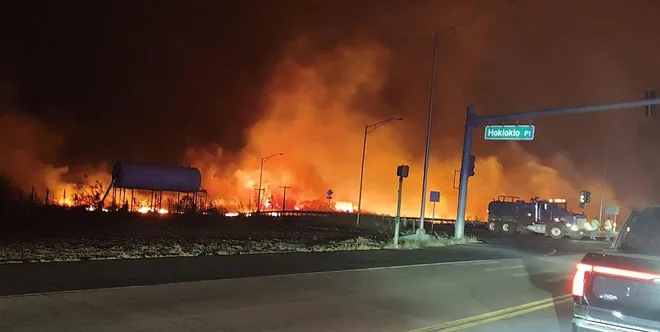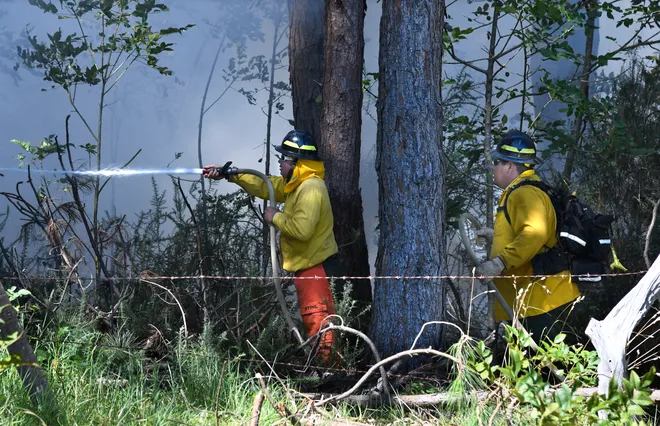
Wildfires are currently raging across Hawaii, and they’ve been intensified by strong winds coming from a passing hurricane. This unfortunate situation has resulted in hundreds of evacuations, widespread power outages affecting thousands of people, and the destruction of numerous homes. The fires have even driven some residents to seek refuge in the ocean to escape the advancing flames.
Table of Contents – Hawaii Wildfires
The fires are impacting three key areas on the island of Maui: Lahaina, which is a mix of residential and tourist districts; Kula, a residential region in the mountainous Upcountry; and Kihei, which houses a variety of residential homes, vacation rentals, and visitor facilities. The fires have caused significant damage to multiple structures, and emergency crews are currently fighting against both brush and structural fires. However, the exact number of evacuees, the extent of the fires, and the full scope of the damage remain unclear.
Authorities have taken swift action to address the crisis. Acting Governor Sylvia Luke and Maui Mayor Richard Bissen have declared states of emergency in response to the wildfires. The Hawaii National Guard has been mobilized to assist the Maui Police Department in managing traffic control points.
The Situation Now
The situation has been exacerbated by the presence of Hurricane Dora, which is passing south of the islands. The combination of this hurricane and a strong high-pressure system north of the state has led to powerful and damaging winds. These intense winds, along with low humidity levels, have created hazardous fire weather conditions that are predicted to persist.
The impact on the community has been profound. Residents have been forced to flee their homes, some of which have been destroyed by the flames. Even the iconic Lahaina Front Street has been engulfed in fire, leading to the loss of homes and businesses. The Coast Guard has been rescuing people who have entered the ocean to escape the smoke and fire.
The effects on daily life are evident, with schools being closed due to the fires, and thousands of people stranded at the Maui airport due to canceled flights or lack of transportation. Additionally, the loss of power and downed power lines have further complicated the situation, and even 911 service has been disrupted in some areas.
Administrative efforts

The efforts to combat the Hawaii Wildfires have been challenging due to the strong winds, which prevent helicopters from effectively dropping water on the fires. Firefighters are also facing roadblocks caused by downed trees and power lines.
The uncertainty of the situation is palpable, as the fires’ path and intensity are difficult to predict. Officials have cautioned that the erratic winds, challenging terrain, and dry conditions make it hard to foresee where the fires might spread next. Despite these challenges, emergency shelters have been set up to provide a safe haven for evacuees, and efforts are ongoing to protect lives, homes, and communities.
Maui impact
The fires have not only impacted Maui but have also spread to the Big Island, where similar challenges are being faced in containing the flames and safeguarding homes and infrastructure.
Overall, the situation remains complex and dynamic, with emergency response teams working tirelessly to manage the fires, protect residents, and mitigate the extensive damage caused by this unfortunate series of events.
The ongoing wildfires in Hawaii have created a scene of devastation and upheaval. The flames, exacerbated by strong winds from a nearby hurricane, have triggered a cascade of events that have upended the lives of countless individuals.
In Hawaii Wildfires, Maui, where the fires have hit hardest, the affected areas encompass not just physical structures, but also the emotional and social fabric of the community. Lahaina, a bustling tourist and residential area, has turned into a battleground against the encroaching flames. The iconic Front Street, once a bustling center of activity, now stands engulfed in fire, rendering homes and businesses alike as casualties of this raging inferno.
Location Population
The resilience of the local population is evident in their efforts to escape the blaze. Some have been forced to flee to the ocean to escape the smoke and flames, a last-ditch attempt to find safety amidst chaos. The Coast Guard’s response, plucking people from the ocean to deliver them to relative safety, stands as a testament to the extraordinary measures individuals are willing to take in the face of such a relentless threat.
The impact on daily life has been profound and far-reaching. Schools have been closed, leaving students without their educational routine and parents grappling with the logistics of evacuation. The Hawaii Department of Transportation has worked tirelessly to shelter stranded passengers at the Maui airport, where disrupted flights have left more than 2,000 people with nowhere to go. The absence of power and damaged infrastructure have created additional hardships, especially for those without communication tools as basic as a working phone.
Amidst the chaos, the tireless efforts of firefighters and emergency response teams stand out as a beacon of hope. These brave men and women are battling the elements, pushing back against the flames, and putting their own safety on the line to protect lives, homes, and livelihoods. Their struggles are compounded by the challenging terrain, the unpredictability of the fires’ path, and the overwhelming wind conditions that prevent aerial firefighting efforts.
The emotional toll is also significant. Evacuated residents worry about the safety of loved ones and the fate of their homes. The sheer scale of destruction, coupled with the uncertainty of the situation, has left communities grappling with feelings of helplessness and anxiety.
Amidst the chaos, stories of unity and support have emerged. Emergency shelters have opened their doors, offering refuge to those displaced by the fires. The Red Cross, in collaboration with local authorities, has played a vital role in providing assistance and comfort to those in need. It’s in these moments of crisis that the true strength and resilience of a community shine through.
While the immediate priority remains containing the fires and ensuring the safety of everyone involved, there will undoubtedly be a long road to recovery ahead. Rebuilding homes, restoring infrastructure, and supporting those who have lost so much will require not only physical effort but also a collective spirit of endurance and renewal.
As Hawaii Wildfires battles this unprecedented incident, the determination to rise from the ashes and rebuild will serve as a powerful testament to the human spirit. The scars left by these wildfires will run deep, but so too will the stories of survival, solidarity, and the unwavering commitment to rebuild what has been lost.
The scenes unfolding in Hawaii are a stark reminder of nature’s unpredictability and the fragility of our human habitats in the face of such forces. The wildfires, fueled by a combination of strong winds and dry conditions, have turned once-vibrant neighborhoods into charred landscapes, leaving families displaced, businesses destroyed, and communities in shock.
The haunting image of residents seeking refuge in the ocean to escape the flames is a poignant symbol of the desperation that can arise when faced with a threat of this magnitude. It also underscores the urgent need for comprehensive disaster preparedness plans that consider the complex interplay of natural phenomena and their potential consequences.
The devastation reaches beyond physical structures. It affects the bonds between neighbors, the memories held within homes, and the sense of security that comes from living in a tight-knit community. The emotional toll of such an event can be overwhelming, as individuals grapple with the trauma of losing their possessions, their sense of place, and sometimes even their loved ones.
The response of the local authorities, emergency services, and organizations like the Red Cross is a testament to human compassion and resilience. These dedicated individuals are working tirelessly to provide aid, comfort, and guidance to those who have been affected by the fires. Their efforts remind us that even in the darkest of times, acts of kindness and solidarity can light a path forward.
Looking ahead, the process of rebuilding will be a monumental challenge. It involves not only physical reconstruction but also psychological recovery. Communities will need to rally together, drawing strength from each other and from the shared determination to rebuild their lives and restore their neighborhoods.
In this interconnected world, the wildfires in Hawaii Wildfires serve as a sobering reminder that our planet’s delicate balance can be disrupted in an instant, with far-reaching consequences. As communities face these trials, it’s an opportunity for society as a whole to reflect on the importance of environmental stewardship, sustainable practices, and proactive measures to mitigate the impact of such events.
Ultimately, the fires in Hawaii are a chapter in a larger story of human tenacity in the face of adversity. They highlight our capacity to come together, to support one another, and to find hope amid devastation. While the scars left by these fires will undoubtedly remain, they will also be a testament to the human spirit’s ability to endure, rebuild, and emerge stronger than before.


